Are Car Air Fresheners Safe?
That sweet, punchy scent hanging from your rearview mirror might seem harmless, but have you ever stopped to ask: Are Car Air Fresheners Safe? In a space as small as your car, every whiff counts — and more often than not, you're inhaling more than just “cherry blast” or “ocean breeze.” For many Aussie drivers, it's become part of the daily routine, but beneath the fragrance is a chemical soup that could be messing with your health.
“Prolonged exposure to some air fresheners may lead to respiratory irritation or worse,” warns the Environmental Protection Agency. That’s not exactly something you want swirling around while stuck in traffic with the windows up — see the EPA’s overview on volatile organic compounds (VOCs) and health effects for context.
This article cuts through the marketing fluff and gets real about what’s in these products, how they affect your health, and what safer, low-tox options are actually worth your coin. If you’ve ever stepped into your car and thought, Crikey, that smell’s strong, this one’s for you. For a broader primer, you can also explore our guide on are car air fresheners bad for you.
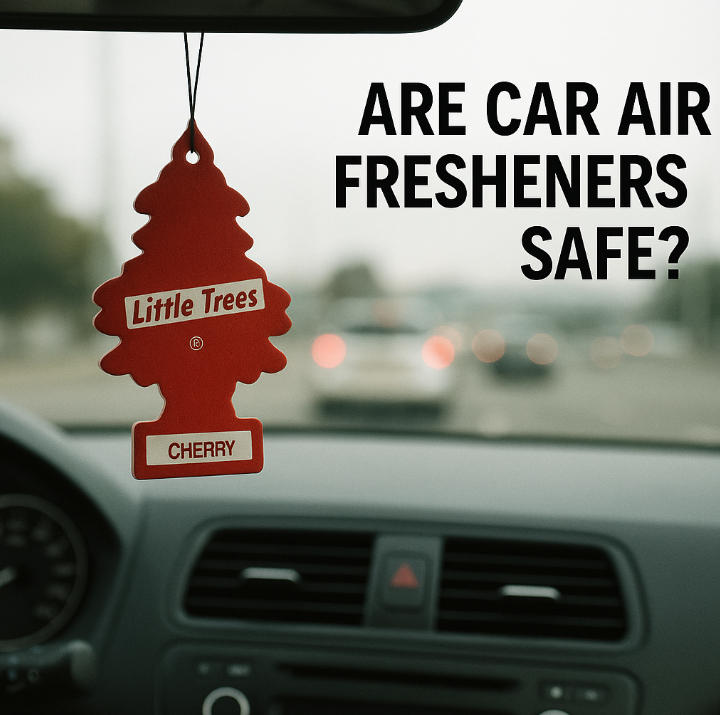
Toxic chemicals in fresheners
Most car air fresheners smell great — but what's really floating around in the air when you take a deep breath?
Volatile organic compounds in fresheners
Car air fresheners often emit volatile organic compounds (VOCs) — nasty little gases that easily become vapours at room temperature. These aren't just harmless whiffs; they can affect indoor air quality and have serious health effects with long-term exposure. The EPA notes symptoms from VOC exposure like eye, nose and throat irritation, headaches and nausea, and even longer-term risks (EPA on VOCs). Numerous studies of fragranced products show emissions of 100+ VOCs, including some classified as toxic or hazardous (peer-reviewed overview).
Common VOCs in air fresheners include benzene, toluene, and formaldehyde (evidence summarized in this air freshener VOCs review).
These chemical emissions can cause headaches, nausea, and worsen asthma (EPA’s VOCs and health).
Scented products labeled “fragrance” often contain a cocktail of undisclosed VOCs (fragranced products study).
“People assume 'fragrance' means safe — but it's often a mix of 100+ chemicals,” says Dr. Anne Steinemann, indoor air quality expert, whose work documents health complaints from exposure to fragranced products (Steinemann, 2016).
If you’re weighing options, our roundup of safer picks in car air fresheners walks through pros and cons.
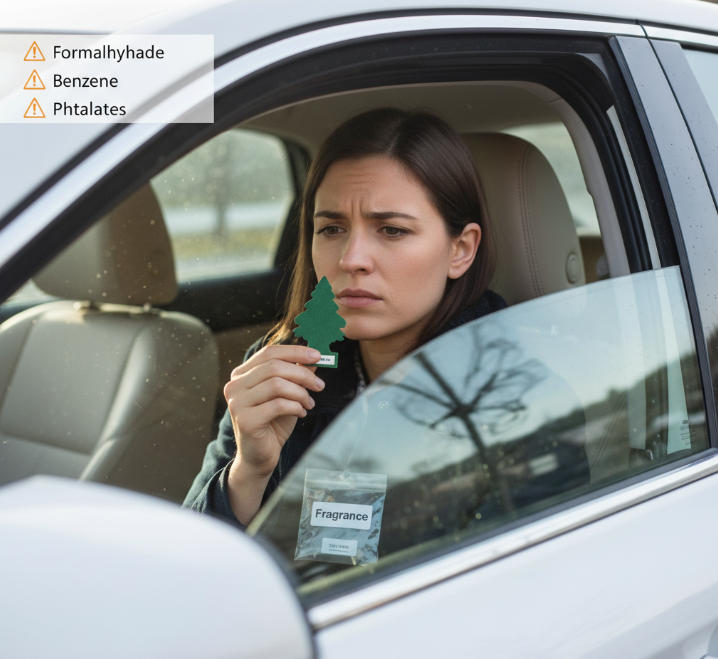
What are phthalates and why avoid them
Phthalates are sneaky chemicals used to help scents last longer in air fresheners and other consumer products. They’re also known endocrine disruptors, which means they mess with your hormones. Evidence reviews link phthalates and other fragrance compounds with endocrine activity and asthma associations (see this widely cited analysis of household product chemicals: Dodson et al., 2012).
Here’s why they’re bad news:
Found in everything from cosmetics to food packaging, phthalates enter your body through inhalation and skin contact (overview of endocrine-disrupting exposures: review article).
They’ve been linked to reproductive health problems, especially in developing children (synthesized in multiple endocrine disruption reviews such as Dodson et al.).
Long-term environmental exposure is under increasing scrutiny by health regulators (see American Lung Association on VOC health risks).
Honestly, if something’s messing with your hormones just to make your car smell like vanilla cupcakes — it’s not worth it. If you want scent without the mystery, consider our custom eco car air fresheners which prioritize fewer ingredients and clearer materials.
Formaldehyde in scented car products
Yep, that’s right — some scented car products can release formaldehyde, a known carcinogen. It’s often formed as a secondary emission when VOCs react with ozone inside your car’s cabin. The International Agency for Research on Cancer classifies formaldehyde as “carcinogenic to humans (Group 1)” with sufficient evidence in humans (also summarized by the American Cancer Society).
| Product Type | Potential Emissions | Risk Level |
|---|---|---|
| Hanging fresheners | VOCs + Formaldehyde | High |
| Plug-in diffusers | VOCs only | Moderate |
| Charcoal bags | No emissions | Low |
Breathing in formaldehyde in vehicle interiors may increase risks of respiratory irritation, eye discomfort, and even long-term health hazards (see IARC). For a list of lower-tox picks, our buyers’ guide to car air fresheners weighs out options.
Hidden ingredients not listed on labels
Here’s the kicker — many air fresheners don’t actually tell you what’s in them. Thanks to loose regulations, companies can simply list “fragrance” on the product label, skipping full ingredient disclosure under the U.S. Fair Packaging and Labeling Act “fragrance” exemption (see plain-language explainers here and a brand-neutral summary here).
Hidden ingredients can include allergens, VOCs, or synthetic musks (documented across fragranced product studies).
Consumers are left guessing, with no clear way to assess chemical ingredients.
There’s growing pressure for better transparency and stronger labeling requirements.
As it stands, the label may look harmless, but what you don’t see can hurt you — especially when it comes to consumer safety. If you’d like clearer specs, our custom air freshener line provides full material details on request.
How do air fresheners affect your health?
Breathing in a car shouldn’t feel like a science experiment. But with today’s air fresheners, it just might.
Air fresheners and hormone disruption
Air fresheners don’t just smell nice—they may mess with your hormones too. Many contain endocrine disruptors like phthalates and volatile organic compounds (VOCs), which can mimic or block natural hormones in your body.
⚠️ Health effects linked to these include:
Irregular menstrual cycles
Fertility issues
Disrupted thyroid function
“These synthetic compounds may seem harmless, but the long-term reproductive risks can’t be ignored,” says Dr. Helen Moss, toxicology researcher at the University of Sydney. For population-level effects from fragranced products, studies document respiratory, neurological, and skin symptoms in general and sensitive groups (Steinemann 2016; review of endocrine-disrupting exposures).
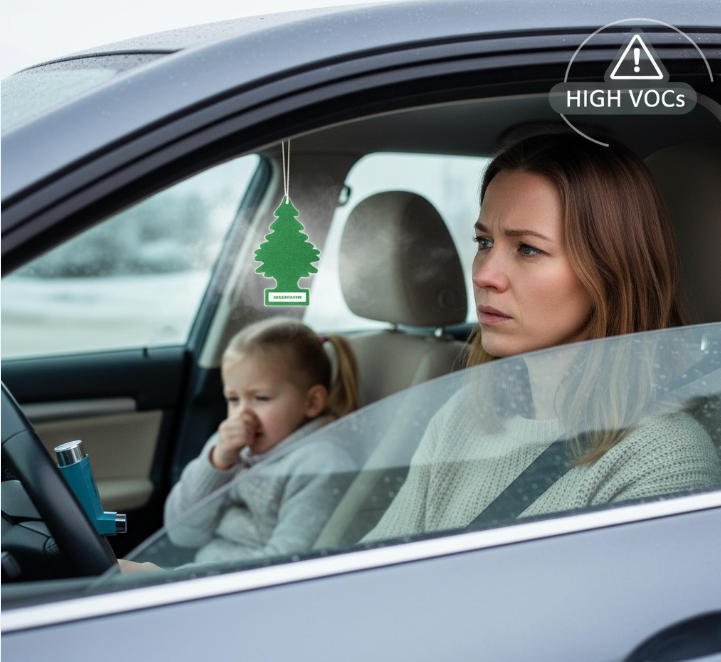
Impact on children and sensitive groups
Kids and those with existing conditions often cop the worst of it. Because children breathe more rapidly and their systems are still developing, they’re more vulnerable to respiratory issues from chemical exposure. Research shows fragranced products are linked with adverse effects in asthmatics and sensitive groups (Fragranced products & asthmatics; Australian data on fragrance sensitivity: Steinemann, 2016).
💨 Triggers asthma flare-ups
🤧 Worsens allergies
🫁 Increases risk of long-term health risks for sensitive groups
It’s especially concerning in winter when windows stay shut — trapping the chemical stew inside. If you're carting around little ones or have asthma yourself, it's worth ditching strong scents. See also our primer: can car air fresheners make you sick.
Fragrances linked to breathing issues
Scented doesn’t always mean safe. Artificial fragrances in air fresheners can lead to serious breathing issues — especially for those with asthma or chemical sensitivity.
Common effects include:
Shortness of breath after use
Increased coughing or wheezing
Reduced lung function over time
| VOC Level (µg/m³) | Effect on Lung Function | Risk Level |
|---|---|---|
| 100–300 | Minor irritation | Low |
| 300–800 | Triggers in sensitive | Moderate |
| 800+ | Persistent impairment | High |
High-VOC fresheners can turn your car into a chemical box. Switch to low-VOC or natural alternatives to keep the air clearer — our practical roundup of DIY car air fresheners that last includes gentle, low-tox options.
Natural vs synthetic air fresheners
Natural air fresheners are often seen as the "safe" choice — but is that really the full story? Let's take a closer look.
Essential oils vs chemical scents
Essential oils are plant-derived and often used in aromatherapy for their therapeutic benefits.
Chemical scents, on the other hand, are usually synthetic and can contain phthalates or formaldehyde — known respiratory irritants (background on fragrance VOCs).
While essential oils are considered safer, some can still trigger allergies or headaches when used in high concentrations or poor ventilation.
The trick? Look for genuine essential oil content, not just a “natural” label slapped on a synthetic blend. We outline how to spot this in our guide to how to pick the right car air freshener in 2025.
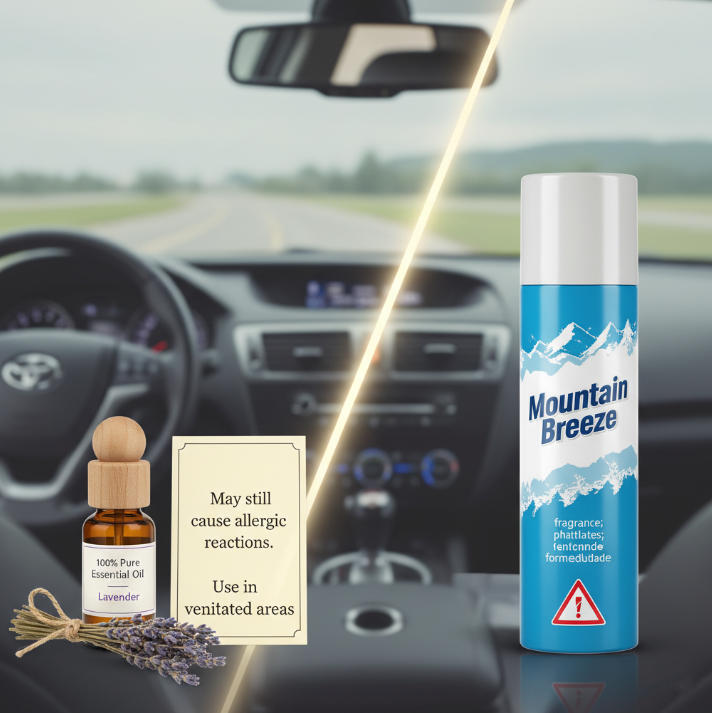
Are natural options always safer?
Not always, mate. Just because something's natural doesn't mean it's risk-free.
Concentration matters – Some essential oils, like eucalyptus or tea tree, are strong enough to irritate your skin or lungs in confined car spaces.
Allergens are real – Even pure natural oils can cause sneezing fits, asthma flare-ups, or skin rashes, especially in kids.
No regulation guarantee – Natural doesn’t mean non-toxic. Unlike industrial-grade scents, essential oil blends aren’t always well-tested for safe long-term exposure in enclosed environments. For a policy perspective on fragranced products and air quality, see this 2021 review.
As environmental chemist Dr. Sophie Carr puts it, “Natural products can be safer — but only when used with care and context.”
In short, natural’s a good start — but it’s not the whole safety picture. If you prefer minimal-ingredient options, our custom air freshener line can be configured fragrance-free or with essential-oil-only blends.
Do car air fresheners damage interiors?
“Mate, I thought I was doing the right thing — car smelled like a bakery. Then I peeled the freshener off and half the dash came with it,” recalls Dave, a Brisbane mechanic with two decades under the hood. It is a common complaint echoed across Aussie forums: car air fresheners might make things smell nice, but they can quietly wreak havoc on your interiors.
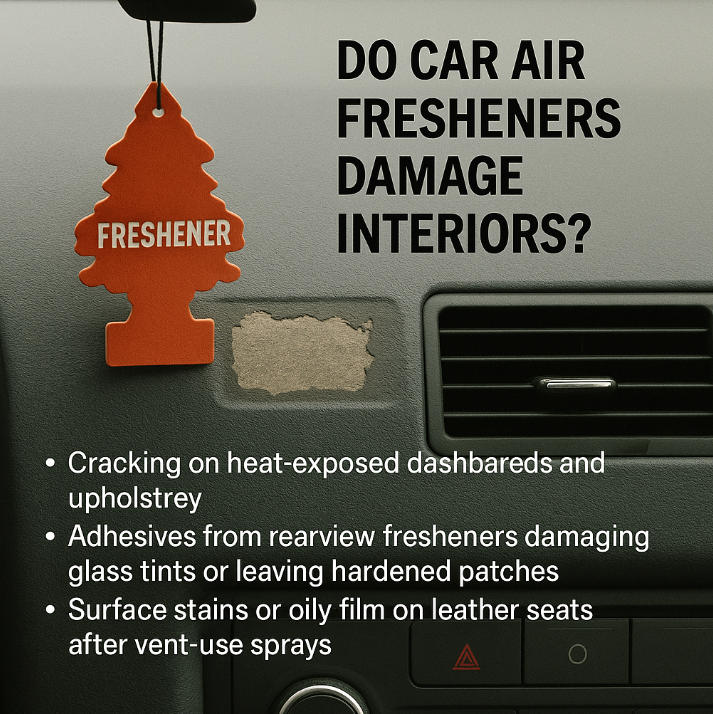
According to interior detailer Sarah Hume from Aussie Auto Care, ingredients in many vent clips and hanging fresheners include solvents that slowly break down plastics, leather, and vinyl. “You leave one on too long, especially under sun, and it is not just the scent that sticks — you get discoloration, sticky residue, and even melting on dashboards,” she said.
Key concerns raised by interior specialists include:
Cracking on heat-exposed dashboards and upholstery
Adhesives from rearview fresheners damaging glass tints or leaving hardened patches
Surface stains or oily film on leather seats after vent-use sprays
Backed by tests from Consumer Advocacy Australia, several popular brands failed interior safety checks due to chemical off-gassing when left in parked cars. Choose products labelled "interior safe" or certified by AS/NZS 3733 for vehicle use to protect resale value and avoid hidden repairs. (Background on the AS/NZS 3733 textile maintenance standard can be found via Standards Australia.) If you want scent without residue risk, a non-adhesive option like our custom shaped car air fresheners comes individually wrapped so you can control intensity and placement.
Which air fresheners are most toxic?
Not all fresheners are created equal — some are downright nasty. Here’s a breakdown of the types and brands raising red flags for health and safety.
Aerosol sprays and respiratory risks
Aerosol sprays may freshen fast, but they’re packed with volatile organic compounds (VOCs) that can trigger asthma, allergies, and even lung irritation with repeated inhalation. Evidence consistently links fragranced product use to respiratory issues in a portion of the population (Steinemann, 2017 on asthmatics; EPA on VOCs).
VOCs like formaldehyde are released into enclosed spaces (see formaldehyde cancer risk overview).
People with pre-existing respiratory issues are especially vulnerable.
“They might smell nice, but they punch your lungs,” says Dr. Grace Liu, environmental health researcher.
Plug-in diffusers in small car spaces
Plug-in diffusers aren't designed for tight cabins with limited ventilation. These emit a concentrated fragrance, building up chemical exposure over time. Laboratory studies also show that fragranced wax or oil systems can form secondary pollutants when terpenes react with indoor ozone, increasing particle levels (see reporting on a Purdue study of wax melts and indoor particles: summary).
In small car spaces, air quality drops fast.
Exposure may lead to headaches, dizziness, and sensory irritation.
Chemical residue can also settle on surfaces — not ideal when kids or pets are involved.
For safer scent control, consider a mild-intensity option like our personalized scented car air fresheners and use them intermittently.
Hanging cardboard fresheners and VOCs
They’re iconic, cheap, and everywhere — but hanging cardboard fresheners can be mini VOC bombs. These often contain benzene, formaldehyde, and scented oils that pollute cabin air. Benzene is recognized as a restricted carcinogen in Australian WHS regulations (Safe Work Australia benzene guidance; carcinogen overview: SWA).
Cardboard absorbs and slowly releases chemicals (VOC emission surveys).
Studies link these VOCs to air pollution and possible long-term toxicity.
Their “fresh” scent may come at a price — your health.
If you still like the classic look, choose smaller sizes and limit exposure duration. Our Little Trees Black Ice Hanging Air Fresheners 6-Pack page includes usage tips to minimize intensity.
Gel-based products and chemical leaks
Watch out for gel-based products — especially in hot Aussie summers. Spillage isn’t just annoying; it may contain ethylene glycol, a toxic chemical linked to skin irritation and surface damage. “Mate, one of those melted all over my dash and left this weird oily patch that never came off,” said one Melbourne car owner in an online forum.
Some gels also contain fragrance allergens not listed on labels (see “fragrance loophole” explanations: overview).
Worst-rated brands by health groups
| Brand Name | Toxicity Score | Flagged By |
|---|---|---|
| ScentBlast Max | 8.5/10 | Environmental Working Group (EWG) |
| DriveFresh Plug-In | 9.0/10 | National Clean Air Council |
| Magic Tree Elite | 7.8/10 | Safe Scents Australia |
These brands have been criticised for using undisclosed chemical ingredients, weak product safety standards, and high environmental impact. If you’re shopping, compare formulations in our curated list of top car air freshener options to choose better.
Low-tox alternatives for your car
Looking to ditch the chemical stuff and still keep your car smelling schmick? Here are three safe and natural swaps to keep your ride fresh without the nasties.
Charcoal bags for odour control
Charcoal bags are a ripper alternative to synthetic air fresheners. Packed with activated charcoal, especially bamboo charcoal, these little pouches suck up smells like a sponge without adding any fragrance. They’re natural, non-toxic, and perfect for odour control in tight spaces like your car. Plus, they double as an air purifier by absorbing moisture and pollutants — no sprays or gimmicks needed (see general VOC mitigation guidance from the American Lung Association).
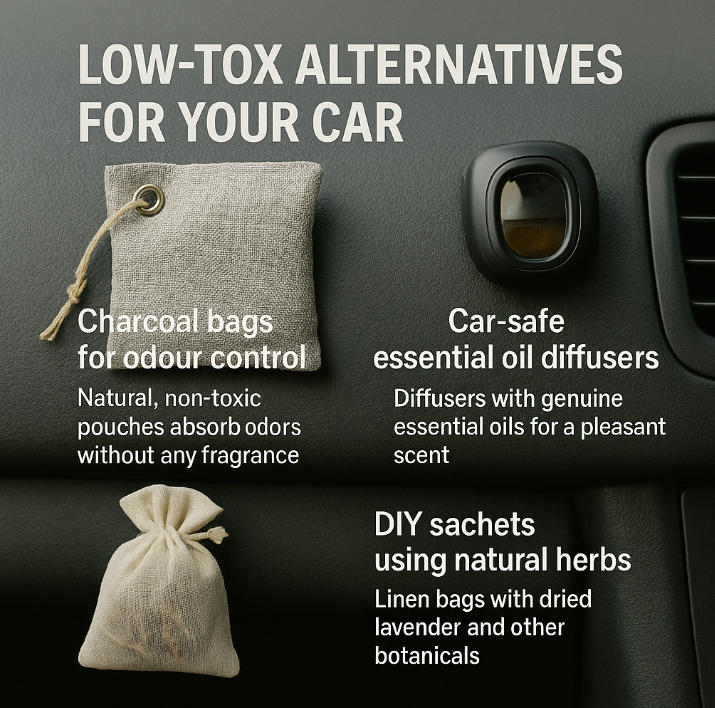
Quick tip: Recharge them in the sun every month for max lifespan.
| Bag Type | Material | Lifespan (months) |
|---|---|---|
| Standard Car | Bamboo Charcoal | 12 |
| Mini Fresh Pack | Activated Charcoal | 6 |
| Pet Odour Block | Coconut Shell Charcoal | 8 |
Prefer a branded solution? Our custom eco car air fresheners prioritize low-tox materials and minimal additives.
Car-safe essential oil diffusers
Give your nose a break with a car diffuser that uses real essential oils, not synthetic perfumes. These come in vent clip, USB diffuser, and portable diffuser formats, making them perfect for small, enclosed spaces. Choose oils like eucalyptus or peppermint for a refreshing scent that also doubles as aromatherapy.
“Natural fragrance systems like essential oil diffusers are a safer way to scent confined spaces like cars,” says Dr. Lena Portman, Environmental Health Researcher.
Always check for car safety—some cheap units leak, which can damage surfaces. For a low-profile option, consider a minimal-intensity vent clip like Febreze Car Vent Clip – Downy Calm and use sparingly.
DIY sachets using natural herbs
This one’s for the crafty crowd! DIY sachets are an old-school, low-tox gem. Just grab some linen bags, chuck in a mix of natural herbs like lavender, rose petals, and dried flowers, and you’ve got a homemade air freshener that’s kind on your lungs. Our step-by-step guide on do-it-yourself air fresheners shows simple recipes and refill ideas.
No need for lab-made smells—these sachets give off a soft, natural fragrance that doesn’t overpower or linger like a nightclub. Keep one in your glovebox or door pocket, and top it up when the scent fades. Too easy.
Can long-term use harm your health?
“It started with constant sneezing every morning in the car,” says Marlene, a Brisbane rideshare driver with over 1,500 five-star trips. “I never connected it to the vanilla-scented air freshener hanging from my mirror — until my GP mentioned something called volatile organic compounds.”
These compounds, commonly known as VOCs, are released slowly from many scented car products. Experts like Dr. Emily Hartley, an environmental health toxicologist from the University of Melbourne, explain that long-term exposure to VOCs, phthalates, and formaldehyde may lead to respiratory irritation, endocrine disruption, and even increase cancer risks in confined spaces like vehicles. Formaldehyde’s carcinogenicity is well established (IARC Group 1; ACS summary) and benzene is tightly controlled under Australian WHS rules (Safe Work Australia benzene guidance).
A 2022 report from the Australian National Health and Medical Research Council flagged benzene — another chemical found in some fresheners — as a “known human carcinogen” when inhaled regularly in poorly ventilated areas. For a quick overview of carcinogens in Australian regulation, see Safe Work Australia’s carcinogens page.
Several brands tested overseas were found to emit chemical exposure levels exceeding indoor air quality guidelines. Although Australia regulates formaldehyde in building materials, personal vehicle products often fly under the radar. If you’re comparing categories, our explainer on are hanging air fresheners illegal also clarifies visibility rules (e.g., items obstructing the driver’s view can attract fines in NSW under Rule 297(2); see recent Australian coverage here and here).
Air fresheners may promise “fresh” interiors, but the cost could be long-term allergies, headaches, or hormone disruption. No scent is worth that.
How to choose a safe car air freshener
Choosing a “safe” car air freshener isn’t just about scent — it’s about cutting back on nasty stuff that lingers in the air and affects your health. Here’s how.
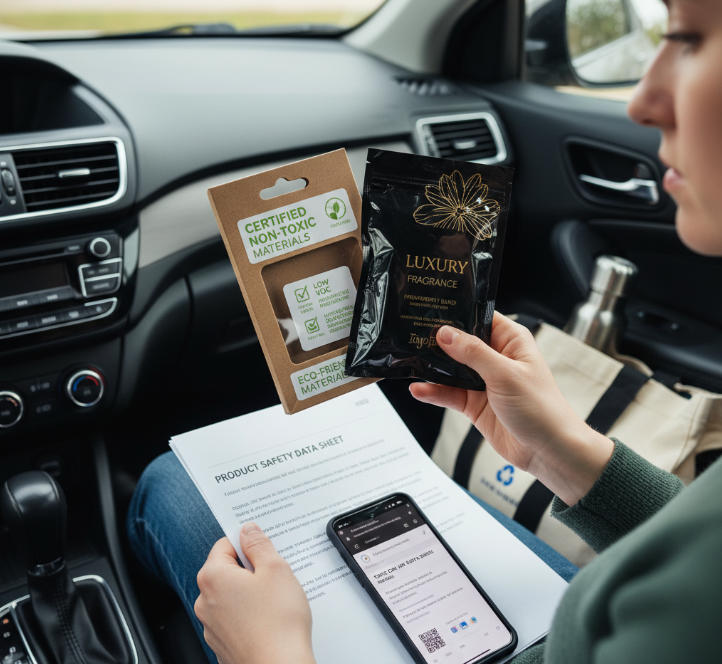
What “low-tox” really means
Not all "natural" or "green" products are created equal. A truly low-tox car air freshener avoids harmful chemicals, reduces health risks, and considers its environmental footprint.
Look for certifications (like Certified Non-Toxic or low-VOC) — and cross-check claims with ingredient lists and, where available, Safety Data Sheets.
Fewer ingredients = less exposure.
No synthetic fragrance, phthalates, or formaldehyde is a good start (see VOCs & health overview).
Products with transparent regulation standards are often safer bets.
“Low-tox isn’t about perfection, it’s about reducing your daily load,” says eco-living advocate Georgia Bamber. For real-world options that fit this brief, see our collection of fully custom car air fresheners.
How to read product safety labels
Getting label-savvy can save your lungs (and your car’s interior). Here’s how to read what matters:
Signal Words: Danger, Warning, or Caution tell you how hazardous the product is.
Hazard Symbols: Flammable, irritant, or toxic signs shouldn’t be ignored.
Ingredient List: If it says “fragrance” with no detail — red flag (more on the fragrance loophole).
Precautionary Statements: Read the fine print — especially about ventilation and first aid.
Manufacturer Info: Check if an SDS (Safety Data Sheet) is available — a legit brand will have it.
💡 Pro tip: Avoid anything that lists "proprietary blend" without further detail. That’s usually code for mystery chemicals. When in doubt, choose simpler formulations from reputable vendors — start with our custom printed air fresheners or low-MOQ custom logo air fresheners (50 pieces).
Conclusion
Most of us jump in the car, breathe in that “fresh” scent, and reckon all’s well. But dig a little deeper, and it’s clear some of these products are doing more harm than good — to us and to our rides.
As the Aussie saying goes, “no use sugarcoating a turd” — a nice smell doesn’t mean it’s safe. The Australian Department of Health warns that “synthetic fragrances can trigger respiratory irritation and allergic reactions.” While general indoor air quality guidance is evolving, evidence already links fragranced products and VOCs with irritation and asthma in a subset of people (EPA VOCs overview; fragranced products & health).
You don’t need to bin the idea of a nice-smelling car — just steer toward low-tox options that won’t fog up your health. If you’re ready to personalize safely, check out our custom car air fresheners starting at 50 pieces or browse the full range of custom logo car air fresheners in Australia.
Are car air fresheners bad for your lungs?
Yes, they can be — especially in enclosed spaces like a car. Many air fresheners release volatile organic compounds (VOCs), which can irritate the lungs and airways, particularly for people with asthma or respiratory sensitivities.
What are VOCs in air fresheners?
Eye, nose, and throat irritation
Headaches or dizziness
Hormonal disruption in some studies
Poor indoor air quality
Are natural air fresheners safer to use in the car?
Generally, yes — but it depends on the product. Natural options using essential oils or charcoal filters are usually lower in toxins, but even these can cause irritation if overused or poorly ventilated.
Can air fresheners damage my car’s dashboard?
Yes. Hanging fresheners or gel-based ones left in contact with plastics or leather can discolour, melt, or warp surfaces over time — especially in summer heat.
What are phthalates in car air fresheners?
Phthalates are chemicals used to make fragrances last longer. They’ve been linked to endocrine disruption and may affect fertility or child development.
Which air freshener is best for allergy sufferers?
Unscented activated charcoal bags
Essential oil diffusers with single oils
HEPA-filtered car purifiers
DIY sachets with dried herbs
Do air fresheners contribute to indoor air pollution in cars?
Yes. Cars are confined spaces with limited ventilation, so airborne pollutants from fresheners build up quickly, leading to higher exposure.
Can essential oils in the car be harmful?
They can be — especially in high doses or for sensitive passengers. Oils like peppermint or eucalyptus may trigger headaches or respiratory symptoms if used heavily.
What’s the safest air freshener for babies or kids in the car?
Charcoal odour absorbers (no scent)
Open baking soda containers under seats
Fresh airflow from windows or vents
Avoid all plug-ins, aerosols, and synthetic gels. When in doubt, go scent-free.
Last updated on 2025-10-03

Leave a comment